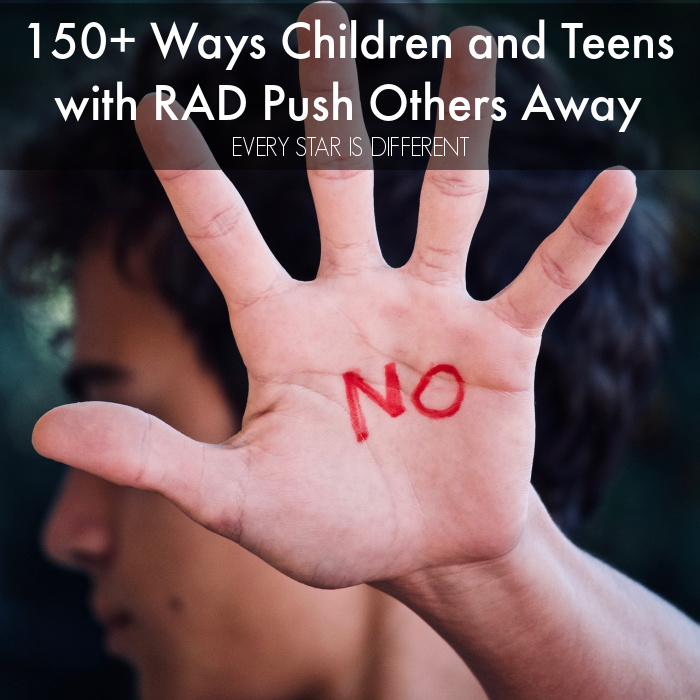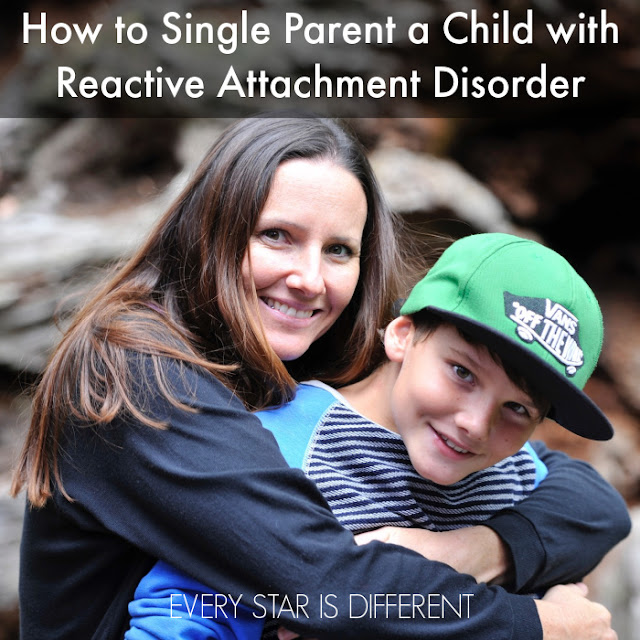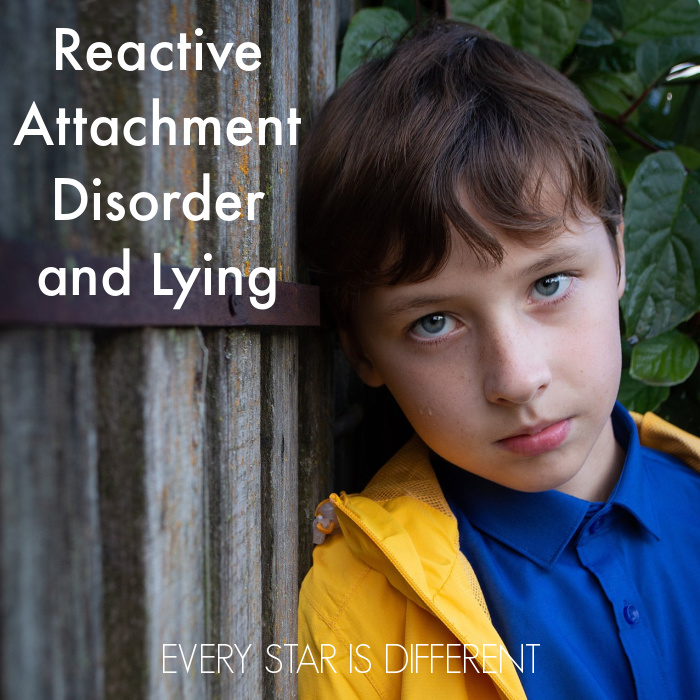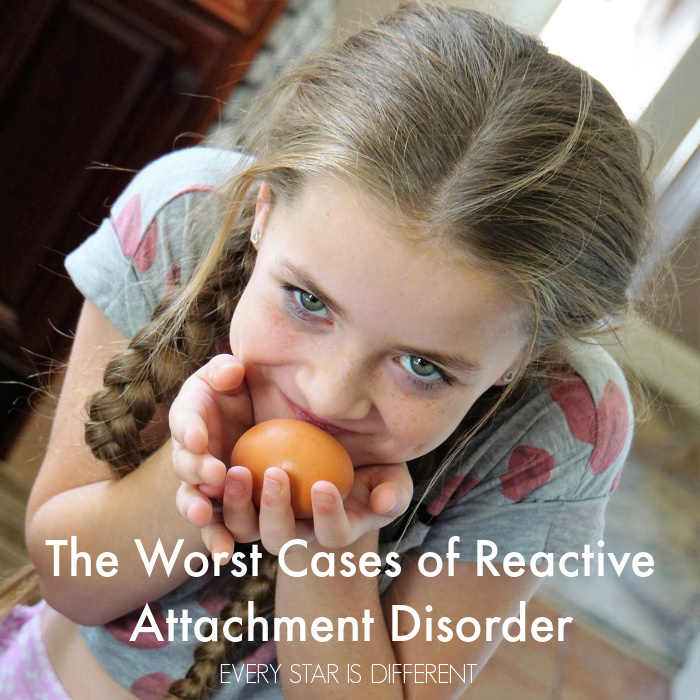Raising a child with Reactive Attachment Disorder changes life in so many ways.
The experience affects all areas of life, including the caregiver's relationships with others.
Extended family relations often take the hardest hit.
This isn't anyone's fault.
Life changes so drastically for the immediate family of a child with Reactive Attachment Disorder.
These changes are impossible for others to understand, unless they've experienced the same things.
Most extended family members have not raised a child with Reactive Attachment Disorder.
A lack of understanding leads to strains and complications in relationships.
Reactive Attachment Disorder changes everything.
10 Ways Reactive Attachment Disorder Affects Extended Family Relations
1. Caregivers of children and teens with Reactive Attachment Disorder experience trauma on a daily basis.
The role of caregiver to a child or teen with Reactive Attachment Disorder has been compared to that of a combat soldier on the battlefield.
Continued trauma takes a toll on the brain and mental health.
PTSD, anxiety, and depression are common.
Daily functioning takes an incredible amount of energy for caregivers.
It's a challenge to make it through each day, doing the absolute best the caregiver can, without feelings of defeat and other strong negative emotions.
Resilience is the goal, but it sometimes feels impossible.
Even when a child or teen with Reactive Attachment Disorder is in a group home or residential placement, the trauma doesn't end.
It's just a different type of trauma.
It is common for those experiencing trauma to withdraw for self preservation purposes, which may result in strained relationships.
Knowing that circumstances can't change in the home with immediately family and Reactive Attachment Disorder, a caregiver may choose to love extended family from a distance, in an effort to preserve and improve their own mental health.
Most often, this is very hard for extended family members to accept, which causes even more strain on relationships.
2. Present trauma triggers past trauma, and becomes complex.
Daily trauma while caring for a child with Reactive Attachment Disorder often triggers past trauma that the caregiver has experienced during childhood and adolescence.
Trauma is real and something that everyone on the planet experiences at one time or another.
No one is exempt.
Trauma is personal.
What may feel traumatic to one person, may not feel that way to another.
An experience may feel completely different to each person involved.
No one wishes trauma on another person.
Everyone does their best to avoid traumatic experiences, especially when children are involved.
Still, trauma happens and is real.
No caregiver is perfect.
Different generations raise children in completely different ways.
Best practices have changed over time.
Raising a child or teen with Reactive Attachment Disorder is a completely different ball game.
Traditional parenting techniques do not work, including those that were passed down by extended family members of a prior generation
When a caregiver is confronted with past trauma, while raising a child or teen with Reactive Attachment Disorder, it is important for the caregiver to seek help from a licensed mental health professional.
It is only after a caregiver has worked through her own past trauma, that she can be all she needs to be for her child or teen with Reactive Attachment Disorder.
Extended family members, especially parents, are often hurt by the idea that the caregiver has experienced past trauma while being raised by them.
There may be a lack of understanding and support from extended family members when a caregiver pursues help from mental health professionals.
This lack of understanding and support can bring about contention and strain in extended family relations.
The lack of understanding and support may also trigger more past trauma.
A caregiver of a child or teen with Reactive Attachment Disorder does not want more contention or trauma in her life.
She cannot eliminate contention and trauma in her home, but she can work through her own trauma and set healthy boundaries with others based on what she can currently handle.
3. Caregivers of children and teens with Reactive Attachment Disorder are most often required to participate in mental health services with immediate family, and for themselves, in order to meet criteria to obtain desperately needed help and assistance.
Extended family may not understand just how many meetings and appointments come with raising a child or teen with Reactive Attachment Disorder.
Meetings and appointments don't begin to describe the obligations of caregivers of a child or teen with RAD when there is a mental health crisis.
A mental health crisis can require a 24/7 commitment from caregivers for weeks, and sometimes months.
Our Pediatric Mental Health Crisis Up Close and Personal
Extended family may not understand requirements set forth by the community in order to receive services and support.
The time commitment and financial responsibilities placed on caregivers are incredibly challenging.
Some extended family members may become upset with how busy a caregiver of a child or teen with Reactive Attachment Disorder is, and the lack of time and energy left to dedicate to other extended family relationships.
The caregiver of a child with Reactive Attachment Disorder cannot eliminate required and recommended mental health services, without consequence.
Extended family relations are often affected negatively by treatment obligations related to a child or teen with Reactive Attachment Disorder.
4. Raising a child or teen with Reactive Attachment Disorder is incredibly expensive, leaving little to no extra funds to participate in special events and trips.
One hallmark behavior that comes with Reactive Attachment Disorder is destruction of property, which results in a significant financial burden for the caregiver.
Even if insurance covers appointments, the cost of travel to appointments is significant.
When a child or teen is in residential, the caregiver is responsible for all transportation expenses, as well as all expenses related to visits and passes.
These expenses are added to the requirement that family provide shoes, clothing, and other items in residential, which are either lost, stolen, or destroyed, and need to be replenished every six months.
The supervision required to keep family members safe while raising a child with Reactive Attachment Disorder, can result in a caregiver no longer being able to work outside of the home.
Must Have Safety Resources When Parenting a Child with Reactive Attachment Disorder
Even with disability assistance, the strain of only one caregiver working, paired with behaviors that result in the destruction of property are significant.
Mental health emergencies prevent caregivers from going to work altogether for an extended period of time, resulting in a loss of income at a time when it's needed most.
There may not be extra money to visit extended family.
Money for fun extended family activities may not exist.
Financial struggles can increase the strain on relationships with extended family.
5. It can be impossible to commit to scheduled visits with extended family, due to behaviors and time commitments associated with Reactive Attachment Disorder.
It is common for a caregiver of a child or teen with Reactive Attachment Disorder to schedule a get together with extended family, and then need to cancel due to RAD behaviors.
A child or teen with Reactive Attachment Disorder may act out in unsafe ways when a caregiver decides to spend time with others.
At times, it can be unsafe to leave a child or teen with Reactive Attachment Disorder with only one care giver, especially when there are other children or teens in the home.
There are times that one caregiver leaving the home triggers the child or teen with RAD so much that she targets the other caregiver and becomes extremely unsafe.
An inability to show up for extended family members in these situations can take a toll on relationships and cause so much strain.
6. Extended family gatherings are a trigger for children and teens with Reactive Attachment Disorder, resulting in severe behaviors before, during, and/or after festivities, which then result in more trauma for the caregiver.
More than anything caregivers are seeking support and respite from the constant struggles with behaviors related to Reactive Attachment Disorder.
Visiting extended family can often provide the opposite experience.
Children and teens with Reactive Attachment Disorder struggle with forming bonds of attachment.
Gatherings with extended family are all about this bonding and attachment experience, which triggers the RAD brain to act out and push others away.
Whether behaviors occur before, during, or after gatherings depends on the child or teen, but all behaviors will most likely be directed towards the caregiver, not the extended family members, unless the child knows them extremely well.
Caregivers will do all in their power to lessen the trauma coming their way.
This often means a caregiver will choose not to participate in extended family get togethers with the child or teen with Reactive Attachment Disorder, and often can't go without the child or teen with RAD.
7. Finding reliable childcare or respite services is next to impossible for caregivers of children and teens with Reactive Attachment Disorder.
It is incredibly difficult to find childcare or respite services for a child or teen with Reactive Attachment Disorder.
Even when a caregiver gets lucky and finds someone who is willing to help, the help is most often short lived when behaviors increase as the child or teen with RAD get to know the respite worker.
In many cases, finding a trauma-informed childcare provider or respite worker is next to impossible.
The few who are willing, may not be qualified or educated on Reactive Attachment Disorder which can cause more harm than good for the family.
8. Meeting the needs of a child or teen with Reactive Attachment Disorder can take all the energy a caregiver has, leaving nothing left to give to others.
Due to the demands of raising a child or teen with Reactive Attachment Disorder, caregivers are often left with nothing left to give to others.
Expectations of the caregiver from others can add to already existing anxiety, overwhelm, etc.
Even a phone call can often feel like too much, and can result in more trauma for the caregiver of a child or teen with Reactive Attachment Disorder, especially if the child or teen feels he isn't receiving the attention she deserves, during the phone call.
A caregiver does not want to dedicate ALL of her energy to a child or teen with Reactive Attachment Disorder, but so often, that's what's required for everyone in the immediate family to stay safe.
A lack of involvement and energy dedicated to extended family can cause strain on relationships.
9. A child or teen with Reactive Attachment Disorder often displays "artificial charm" while spending time with extended family, leading extended family members to believe the child or teen is innocent and the caregiver is the problem.
Almost all children and teens with Reactive Attachment Disorder display "artificial charm" when around others outside of the immediate family.
Caregivers may observe that a child or teen with RAD acts like angel in front of others, and then the exact opposite when alone with caregivers.
This scenario is often the case when time is spent around extended family.
Due to "artificial charm" a child or teen with Reactive Attachment Disorder may be viewed as perfectly innocent, leading others, including extended family, to disrespect boundaries set by the caregiver.
Artificial charm puts caregivers of a child or teen with Reactive Attachment Disorder in an extremely difficult and unsafe position.
No matter what decisions the caregiver makes, when with extended family, related to the child or teen with Reactive Attachment Disorder, there will be consequences later.
The child or teen with RAD will target the caregiver if the caregiver decides to enforce safe boundaries around extended family members.
The child or teen with RAD will target the caregiver if the caregiver decides to go along with extended family member suggestions, because the caregiver is inconsistent in their response to behaviors.
Artificial charm can add so much strain to extended family relations.
10. Triangulation
Another common symptom related to Reactive Attachment Disorder is triangulation, or pitting one caregiver against another, through lies and misinformation.
Triangulation is extremely common in the home with caregivers of a child or teen with Reactive Attachment Disorder.
As a child or teen with Reactive Attachment Disorder grows closer to extended family members, triangulation occurs between extended family and caregivers, which causes a significant amount of strain and contention.
Extended family members may start to believe the lies and misinformation shared by the child with Reactive Attachment Disorder, causing even more difficulties for the caregivers.
Nothing good comes from triangulation.
What Can Extended Family Members Do to Improve Relationships with Caregivers of a Child or Teen with Reactive Attachment Disorder?
1. Show an outpouring of love and kindness towards the caregiver, even when the caregiver's decisions don't make sense.
She needs love and support more than anything else.
2. Understand that loving from a distance doesn't mean the caregiver loves extended family members less.
Keeping distance is about safety and sanity for the immediate family of a child or teen with Reactive Attachment Disorder.
3. Choose to learn more about Reactive Attachment Disorder from the caregiver and other reliable and recommended sources.
You can trust that caregivers have a list of all the books they've read, and would be more than happy to share it. (My recommended book list is coming soon!)
4. Support the caregiver in decisions related to the child or teen with Reactive Attachment Disorder, even when you may not understand or agree with those decisions.
Remember that the caregiver's primary concern is safety for everyone involved, including extended family members.
5. Understand the caregiver's limited opportunities for communication are not about a lack of desire to communicate with extended family members. Phone calls, emails, text messages, et. may go unanswered at times, due to whatever else may be taking up the caregiver's time related to RAD behaviors.
Communication boundaries that the caregiver sets are about the safety and sanity of the caregiver who is facing trauma each and every day, sometimes as a result of communicating with others.
6. Accept that the caregiver of a child or teen with Reactive Attachment Disorder isn't going to be the best at following through with anything including holiday gifts and cards, birthday wishes, get togethers, etc.
This is not because the caregiver doesn't care about extended family members.
Holidays, special occasions, and any family get together are major triggers for the child or teen with Reactive Attachment Disorder, which means those times of year and circumstances are the most challenging for caregivers.
7. Trust the caregiver when she does decide to share details about what's going on.
What she says may sound unbelievable, but that doesn't mean it isn't true.
I have never come in contact with a caregiver raising a child or teen with Reactive Attachment Disorder who hasn't experienced strain in relationships with extended family members.
The strain and loss of extended family relations is yet another traumatic experience that caregivers go through when they choose to love a child or teen who is unable to attach.
Whether you are a blood relative of a caregiver who is raising a child or teen with Reactive Attachment Disorder, or you're a friend or acquaintance, do all you can to show love and support.
Your unconditional love and support may be what saves the caregiver during such difficult times.
If you enjoyed this post, you may also like the resources below.











.jpg)






.jpg)









.jpg)















.jpg)








